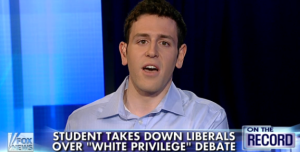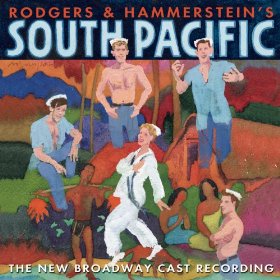
Tal Fortgang on Fox News
There has been a lot in the news recently about white privilege, following the case of Princeton University freshman Tal Fortgang. He reacted to the comment by a classmate that he should “check his privilege” by writing a piece published in Time Magazine. He rejects the idea that there is any kind of white privilege in American society and that he is any way someone who has enjoyed advantages from growing up white and male in a well-to-do upper middle class family. He points to the difficulties in his family history, including his grandparents fleeing the Nazis and immigrating penniless to the U.S.:
Behind every success, large or small, there is a story, and it isn’t always told by sex or skin color. My appearance certainly doesn’t tell the whole story, and to assume that it does and that I should apologize for it is insulting. While I haven’t done everything for myself up to this point in my life, someone sacrificed themselves so that I can lead a better life. But that is a legacy I am proud of.
Fortgang certainly has a point, that who you are is not determined by your gender or your racial identity. We all create our persona from multiple sources and influences, including, as Fortgang emphasizes in the story of his hard-working father, through industry and personal fortitude. But he implies that we all have the same starting point for being successful in US society, which I and many others would argue is not the case. The case for that was made by Peggy McIntosh, a women’s-studies scholar at Wellesley College, in a widely read essay entitled “White Privilege: Unpacking the Invisible Backpack” in which she provides an extensive list of examples, starting out with these:
1. I can if I wish arrange to be in the company of people of my race most of the time.
2. If I should need to move, I can be pretty sure of renting or purchasing housing in an area which I can afford and in which I would want to live.
3. I can be pretty sure that my neighbors in such a location will be neutral or pleasant to me.
4. I can go shopping alone most of the time, pretty well assured that I will not be followed or harassed.
5. I can turn on the television or open to the front page of the paper and see people of my race widely represented.
6. When I am told about our national heritage or about “civilization,” I am shown that people of my color made it what it is.
Interestingly, McIntosh was interviewed a few days ago for a piece in the New Yorker on “The Origins of ‘Privilege’” and commented on the Fortgang controversy:
When Tal Fortgang was told, “Check your privilege”—which is a flip, get-with-it kind of statement—it infuriated him, because he didn’t want to see himself systematically. But what I believe is that everybody has a combination of unearned advantage and unearned disadvantage in life. Whiteness is just one of the many variables that one can look at, starting with, for example, one’s place in the birth order, or your body type, or your athletic abilities, or your relationship to written and spoken words, or your parents’ places of origin, or your parents’ relationship to education and to English, or what is projected onto your religious or ethnic background. We’re all put ahead and behind by the circumstances of our birth. We all have a combination of both. And it changes minute by minute, depending on where we are, who we’re seeing, or what we’re required to do.
McIntosh accepts Fortgang’s that the whole story “isn’t always told by sex or skin color”, but that there are many more factors at play. I was at a conference presentation recently in which the main topic was how to include diversity as a topic in online courses. The first question after the presentation was by the only African-American in the audience. I expected, as did probably the rest of the folks there, for her to comment on diversity from the perspective of growing up black in the US. Instead, she went on at considerable length about what it was like to grow up skinny and suggested that body size be included in discussing diversity and discrimination.
On the lighter side, Buzzfeed has an interactive checklist for seeing how privileged you are. For an alternative view on white privilege, here is Louis CK’s take on being white:
 “You’ve got to be carefully taught” is both a song title, from the 1949 Rodgers and Hammerstein musical South Pacific, and an entry in the Race Card Project. Having grown up partly in Hawaii, I have a special feeling for the musical, but had not thought much about the message of tolerance it contains until a story this morning on NPR on the song, suggested by multiple entries for the song title in the Race Card Project, which happens to have the same number of 6 words called for by the project. The song lyrics are surprising for the year in which they were composed:
“You’ve got to be carefully taught” is both a song title, from the 1949 Rodgers and Hammerstein musical South Pacific, and an entry in the Race Card Project. Having grown up partly in Hawaii, I have a special feeling for the musical, but had not thought much about the message of tolerance it contains until a story this morning on NPR on the song, suggested by multiple entries for the song title in the Race Card Project, which happens to have the same number of 6 words called for by the project. The song lyrics are surprising for the year in which they were composed:
